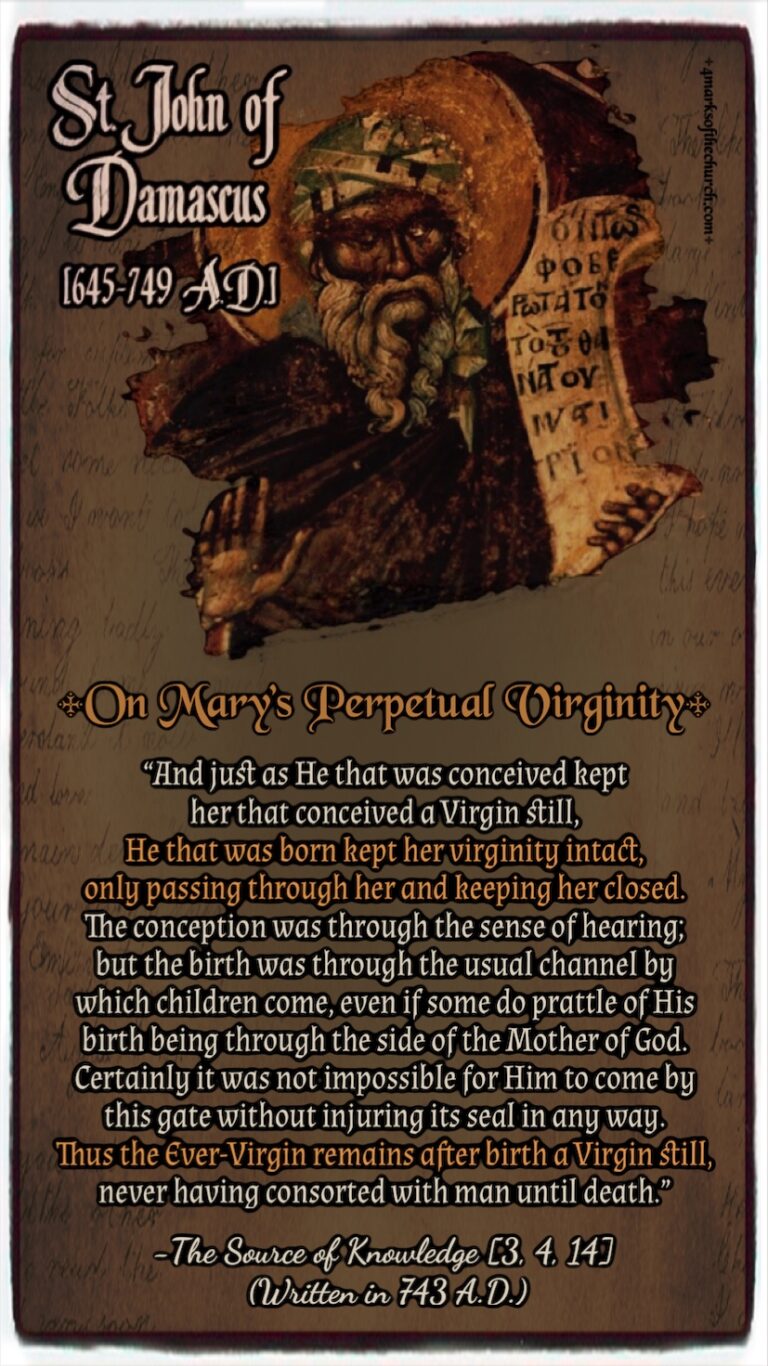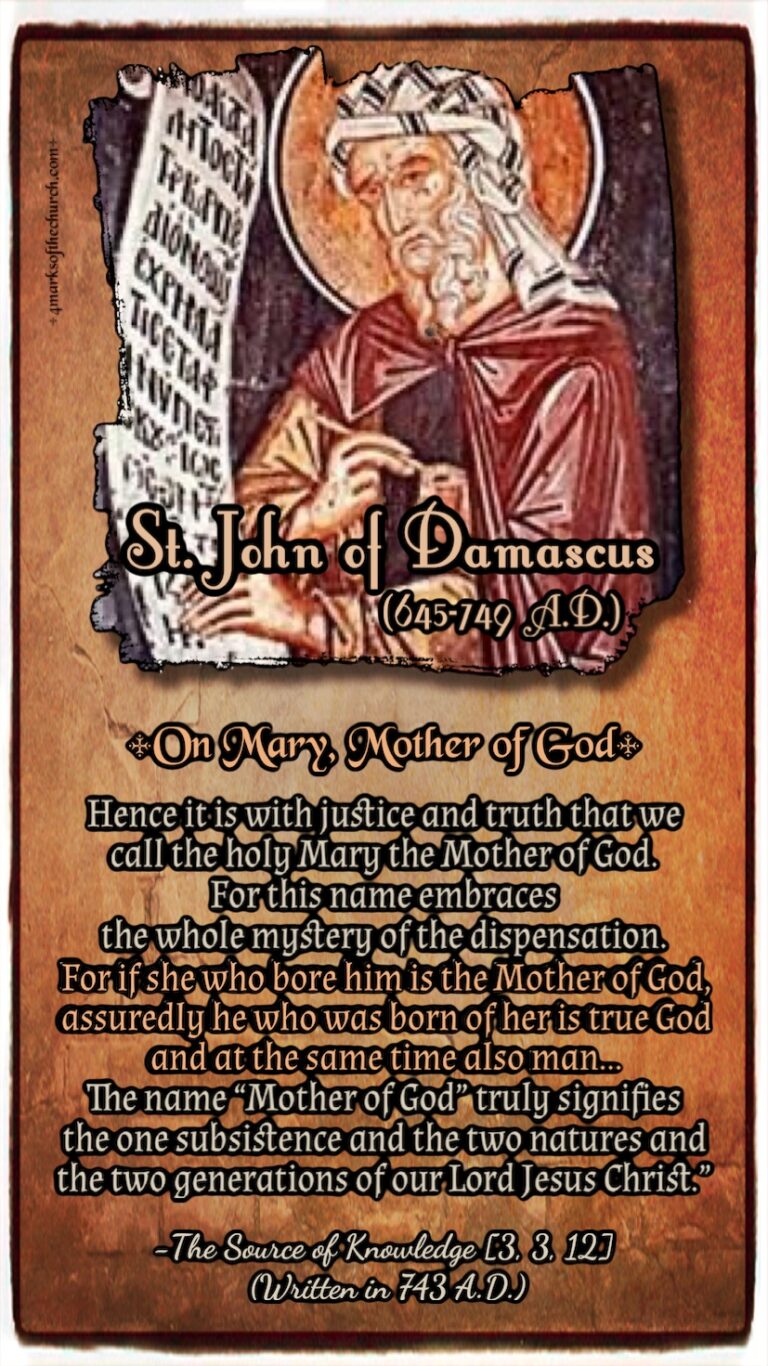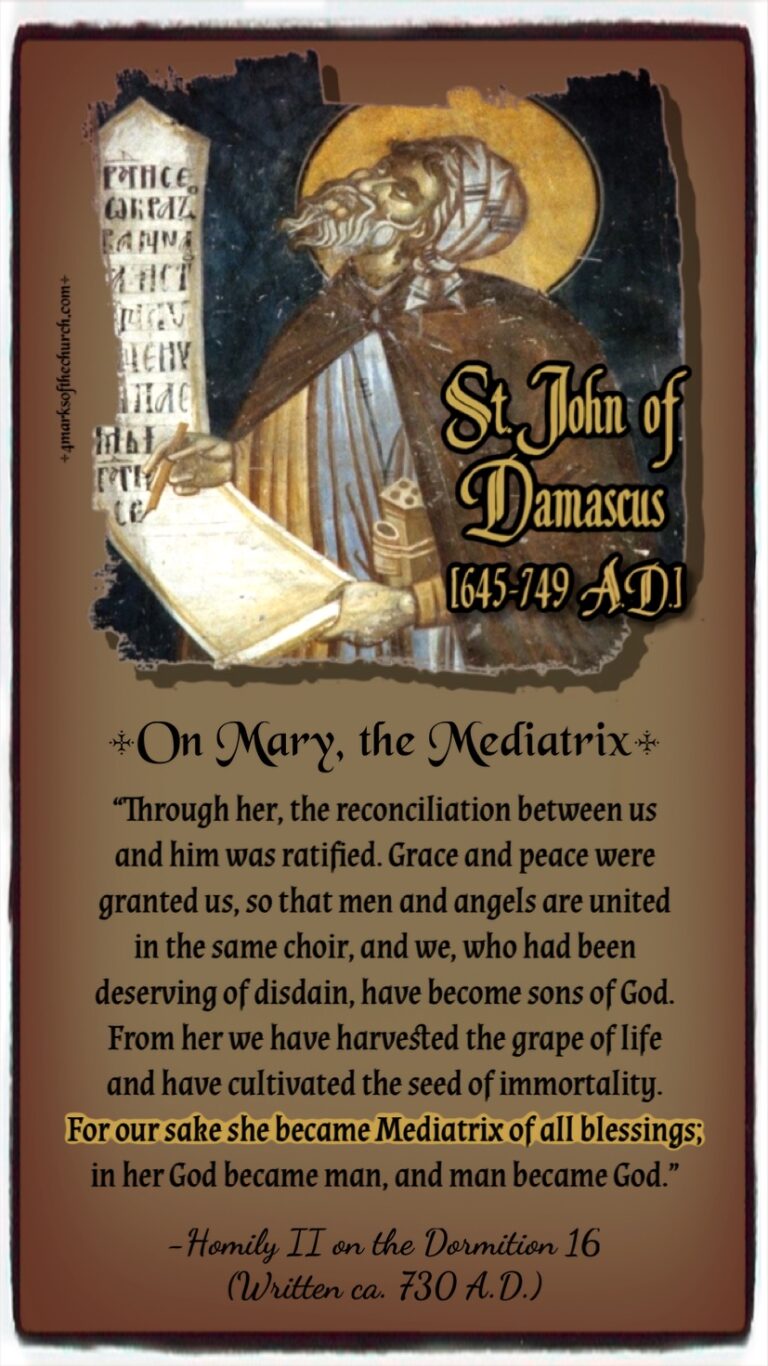St. John of Damascus
Scroll for quotes→












John of Damascus (675-749), or John Damascene, was a monk, priest, hymnographer, apologist, and polymath whose fields of interest and contribution included law, theology, philosophy, and music. He was given the by-name of Chrysorrhoas, meaning the “golden speaker”. He is one of the Fathers of the Eastern Orthodox Church and is best known for his strong defense of icons. The Catholic Church regards him as a Doctor of the Church, often referred to as the Doctor of the Assumption due to his writings on the Assumption of Mary. He was also a prominent exponent of perichoresis, and employed the concept as a technical term to describe both the interpenetration of the divine and human natures of Christ and the relationship between the hypostases of the Trinity. John is at the end of the Patristic period of dogmatic development, and his contribution less that of theological innovation than that of a summary of the developments of the centuries before him. In Catholic theology, he is therefore known as the “last of the Greek Fathers”.
John was born in Damascus, in 675 or 676, to a prominent Damascene Christian Arab family. His father, Sarjun ibn Mansur, served as an official of the early Umayyad Caliphate, which was the second of the four major caliphates, or territories, established after the death of Muhammad. When Syria was conquered by the Muslim Arabs in the 630s, the court at Damascus retained its large complement of Christian civil servants, John’s grandfather among them. John’s father, Sarjun (Sergius), went on to serve the Umayyad caliphs. It is believed that John became a monk at Mar Saba, and that he was ordained as a priest in 735.
In the early 8th century, iconoclasm, a movement opposed to the veneration of icons, gained acceptance in the Byzantine court. In 726, despite the protests of Germanus, Patriarch of Constantinople, Emperor Leo III issued his first edict against the veneration of images and their exhibition in public places. John of Damascus undertook a spirited defense of holy images in three separate publications. The earliest of these works, his Apologetic Treatises against those Decrying the Holy Images, secured his reputation. He not only attacked the Byzantine emperor, but adopted a simplified style that allowed the controversy to be followed by the common people, stirring rebellion among the iconoclasts. Decades after his death, John’s writings would play an important role during the Second Council of Nicaea (787), which convened to settle the icon dispute.
Writings:
- Homily I -On the Dormition of the Holy Mother of God
- Homily II -On the Dormition of the Holy Mother of God
- Homily III -On the Dormition of the Holy Mother of God
- Canon for the Dormition of the Mother of God (Tone IV)
- Early works
- Three Apologetic Treatises against those Decrying the Holy Images
- Fountain of Knowledge or The Fountain of Wisdom
- Concerning Heresy (Perì eréseon)
- Against the Jacobites
- Against the Nestorians
- Dialogue against the Manichees
- Elementary Introduction into Dogmas
- Letter on the Thrice-Holy Hymn
- On Right Thinking
- On the Faith
- On the Two Wills in Christ (Against the Monothelites)
- Sacred Parallels (dubious)
- Octoechos (the church’s liturgical book of eight tones)
- On Dragons and Ghosts
- Teaching on Islam
return to top ⇑
Quotes and Excerpts:
“The Body is truly united to divinity, the Body which was from that of the Holy Virgin; not that the Body which was taken up comes back down from heaven, but that the bread itself and the wine are made over into the Body and Blood of God. If you inquire into the way in which this happens, let it suffice for you to hear that it is through the Holy Spirit, just as it was through the Holy Spirit that the Lord took on Himself from the Holy Mother of God the flesh that subsisted in Himself. More than this we do not know, except that the word of God is true and effective and all-powerful; but the manner (of the Eucharistic transformation) is inscrutable.” – The Source of Knowledge 3. 4. 13 (Written in 743 A.D.)
“And just as He that was conceived kept
her that conceived a Virgin still, He that was born kept her virginity intact, only passing through her and keeping her closed. The conception was through the sense of hearing; but the birth was through the usual channel by which children come, even if some do prattle of His birth being through the side of the Mother of God. Certainly it was not impossible for Him to come by this gate without injuring its seal in any way, Thus the Ever-Virgin remains after birth a Virgin still,
never having consorted with man until death.” -The Source of Knowledge 13, 4,14 (Written in 743 A.D.)
“For those who partake worthily and with faith, it is for the remission of sins and for life everlasting, and a safeguard to soul and body.. The Bread and the Wine are not a type of the Body and Blood of Christ; -perish the thought!- but the deified Body Itself of the Lord, since the Lord Himself has said: ‘This is My Body He did not say a type of His Body, but His Body; nor a type of His Blood, but His Blood.” – The Source of Knowledge 3. 4. 13 (Written in 743 A.D.)
“Jacob contemplated heaven joined to earth by the two ends of a ladder and saw angels going your up and down upon it and saw himself symbolically wrestling with the Strong One, the Invincible. So you have assumed the role of a mediatrix, having become the ladder by which God comes down to us, assuming the weakness of our nature, embracing it and uniting himself to it,
and thus making man into a mind that can see God. Thus O Mary you have reunited what had been divided.”-Homily I on the Dormition 8 (Written ca. 730 A.D.)
“Because through the Eucharist we have communion with Christ and share in His flesh and in His divinity. We do indeed have such communion thereby, that we are united with each other. For since we partake of one Bread we all become one body of Christ and one blood, and members of each other, since we become of one body with Christ. With all our strength, therefore, let us guard against receiving communion from heretics and from giving Communion to them. For the Lord says;
‘Do not give that which is holy to the dogs.’”-The Source of Knowledge 3. 4. 13 (Written in 743 A.D.)
“We proclaim that the Holy Virgin is properly and truly the Mother of God; for since He that was born of her is true God, she that bore the true God, incarnate of her, is true Mother of God. For we hold that God was born of her, not as if the Divinity of the Word took the beginning of His existence from her, but that God the Word, who was begotten of the Father timelessly before the ages, and who subsisted with the Father and with the Spirit eternally and without beginning, in these last days took His abode in her womb for our salvation, and without change took flesh of her and was born. For the Holy Virgin did not bear mere man but true God, not naked but incarnate, not with a body brought down from heaven, not passing through her as through a channel, but homoousios with us, having taken flesh from her, though subsisting in Himself.” – The Source of Knowledge 3. 3. 12 (Written in 743 A.D.)
“Hence it ts with justice and truth that we
call the holy Mary the Mother of God.
For this name embraces the whole mystery of the dispensation. For if she who bore him is the Mother of God, assuredly he who was born of her is true God and at the same time also man. The name ‘Mother of God’ truly signifies the one subsistence and the two natures and the two generations of our Lord Jesus Christ.” -The Source of Knowledge 3, 3. 12 (Written 743 A.D.)
“The incarnate Son of God who was born of [Mary] was not a divinely-inspired man, but
God incarnate… Must she not, therefore, be Mother of God, who bore God incarnate? Certainly she who performed the role of the Creator’s handmaid and Mother is truly and in perfect reality God’s Mother, and Lady and
Queen over all creation.” -The Source of Knowledge 3. 4. 14 (Written 743 A.D.)
“Virginity, the conduct of the angels,
is the property of all incorporeal nature. We do not say this as speaking ill of marriage, -perish the thought! For we know that the Lord blessed marriage by His presence, and we know the saying, ‘Marriage is honorable and its bed undefiled!’ But we say this by way of recognizing that however good marriage may be, virginity is better.” – The Source of Knowledge 3. 4. 24 (Written in 743 A.D.)
“Through her, the reconciliation between us and him was ratified. Grace and peace were granted us, so that men and angels are united in the same choir, and we, who had been
deserving of disdain, have become sons of God. From her we have harvested the grape of life and have cultivated the seed of immortality. For our sake she became Mediatrix of all blessings; in her God became man, and man became God.” -Homily II on the Dormition 16 (Written ca. 730 A.D.)
“It was necessary that the body of the one who preserved her virginity intact in giving birth should also be kept incorrupt
after death. It was necessary that she, who carried the Creator in her womb when
he was a baby, should dwell among the tabernacles of heaven.” -Homily II on the Dormition 14 (Written ca 730 A.D.)
“Even though your most holy and blessed soul was separated from your most happy and immaculate body, according to the usual course of nature, and even though
it was carried to a proper burial place, nevertheless it did not remain under the dominion of death, nor was it destroyed by corruption. Indeed, just as her virginity remained intact when she gave birth, so her body, even after death, was preserved from decay and transferred to a better and more divine dwelling place. There it is no longer subject to death but abides for all ages.” -Homily I on the Dormition 10 (Written ca 730 A.D.)
return to top ⇑